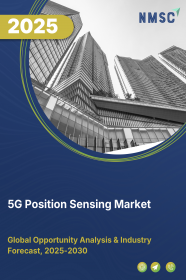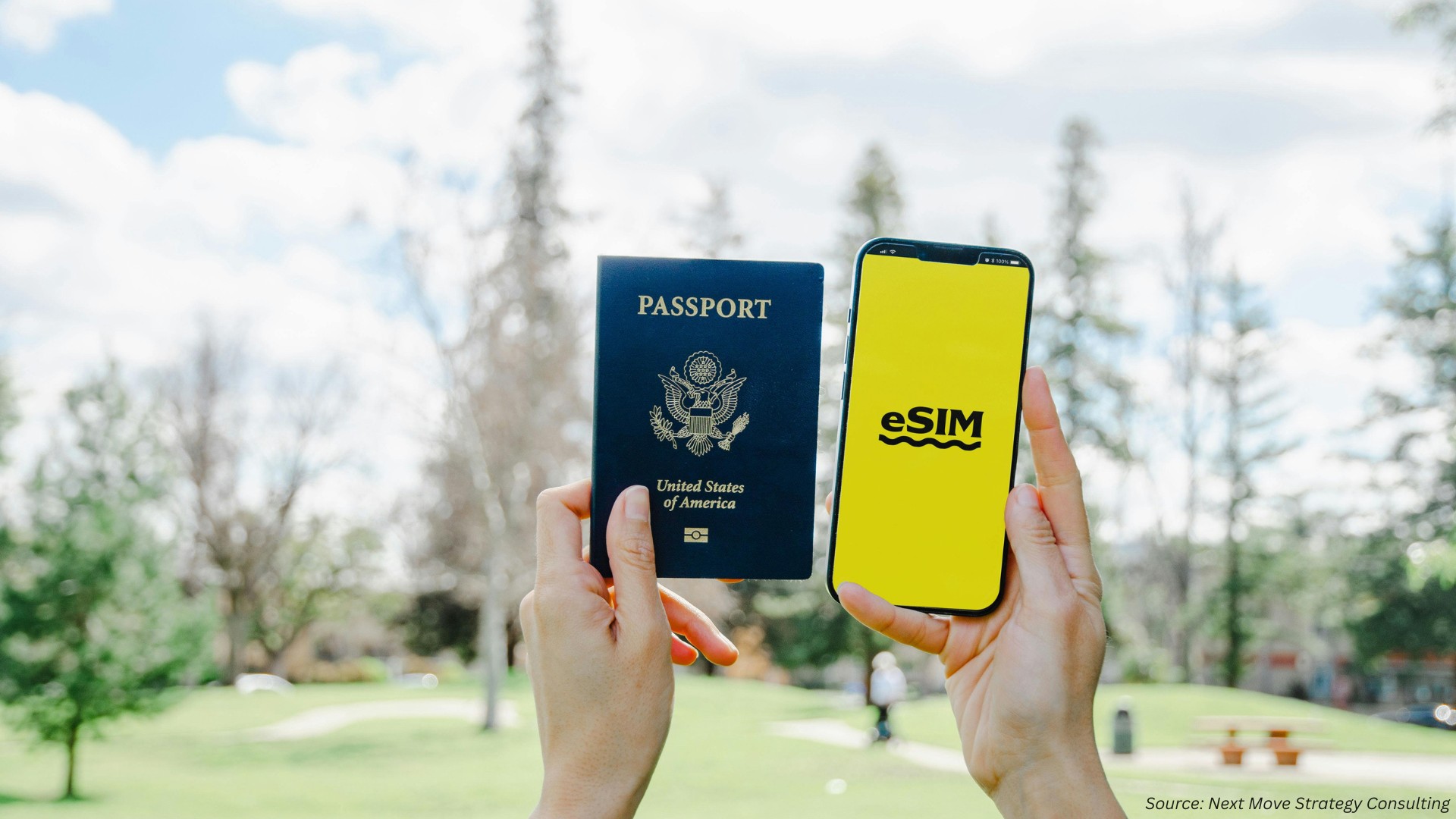
5G Position Sensing Market by Type (Hardware, Software, and Services), by Technology (Angle of Arrival (AoA), Time of Arrival (ToA), and Hybrid), by Application (Navigation & Mapping, Augmented Reality (AR) vs Virtual Reality (VR), Asset Tracking, Robotics & Automation, and Others), and by End-user (Automotive, Consumer Electronics, Healthcare, Aerospace & Defense, Industrial, and Others) – Global Opportunity Analysis and Industry Forecast 2025-2030
5G Position Sensing Market Overview
The global 5G Position Sensing Market size was valued at USD 1.32 billion in 2024 and is predicted to reach USD 3.81 billion by 2030 with a CAGR of 19.3% from 2025-2030. 5G position sensing is a technology that utilizes fifth-generation (5G) cellular network technology to accurately determine the location of devices and objects in real time. This technology uses advanced signal processing techniques to accurately determine the position of devices within the 5G network coverage area.
Unlike traditional GPS systems, 5G position sensing does not rely on satellite signals and can operate indoors and in urban areas where GPS signals can be weak or disrupted. 5G position sensing is used in various industries including autonomous vehicles, industrial automation, smart cities, and location-based services as it can improve safety, optimize production processes, and contribute to more efficient and sustainable city planning.
Market Dynamics and Trends
The growing adoption of IoT devices in various industries such as healthcare, manufacturing, and logistics is driving the demand for accurate position sensing, which is being fuelled by the high-speed and low-latency communication enabled by 5G position sensing technology.
Moreover, the increasing adoption of autonomous vehicles is further driving the growth of the 5G position sensing market, as these vehicles rely on precise real-time positioning data to navigate and avoid obstacles. Furthermore, increasing investment by governments and telecommunications companies around the world to leverage the high-speed, low-latency connectivity of 5G networks is further accelerating the growth of the market. According to the Global System for Mobile Communications Association, mobile operators in the Asia Pacific region planned to invest USD 227 billion from 2022 to 2025 for the development of 5G in Asia Pacific.
However, concerns around radio frequency radiation and its impact on human health along with the privacy and data security risks are the major factors restraining the growth of the market. On the contrary, the introduction of position sensing technologies such as ultrawideband (UWB) and optical sensing along with the integration of blockchain that offers even greater precision, safety, and accuracy in location data are expected to create ample opportunities in the growth of the 5G position sensing market in the coming years.
Market Segmentations and Scope of the Study
The 5G position sensing market share is segmented based on type, technology, application, end-user, and region. Based on type, the market is divided into hardware, software, and services. Based on technology, the market is classified into angle of arrival (AoA), time of arrival (ToA), and hybrid. Based on application, the market is divided into navigation & mapping, augmented reality (AR) vs virtual reality (VR), asset tracking, robotics & automation, and others. Based on end-users, the market is segmented into automotive, consumer electronics, healthcare, aerospace & defense, industrial, and others. Region breakdown and analysis of each of the aforesaid segments include regions comprising North America, Europe, Asia-Pacific, and RoW.
Geographical Analysis
Asia Pacific dominates the 5G position sensing market share and is expected to continue its dominance during the forecast period. The growing adoption and development of 5G technology in the Asia Pacific region is leading to an increased demand for accurate and reliable positioning technologies such as 5G position sensing, which is driving the growth of the market industry. According to the Global System for Mobile Communications Association, China is the largest 5G market in the world, accounting for more than 60% of global 5G connections and the number of 5G base stations in China reached 2.3 million in 2022.
Moreover, the expanding e-commerce industry in the Asia Pacific region is driving the growth of the 5G position sensing market to enable accurate and reliable positioning to ensure that products are delivered to the correct locations. According to the International Trade Administration, China is the largest e-commerce market globally as it reached USD 2.29 trillion in 2020 and is expected to reach USD 3.56 trillion by 2024.
On the other hand, North America is expected to show steady growth in the 5G position sensing market. The growing number of 5G users in North America is driving the demand for accurate and reliable positioning technologies, such as 5G position sensing for location-based services in healthcare along with the growth of the Internet of Things is further boosting the growth of the market. According to the Global System for Mobile Communications Association, 280 million people in the US will be using 5G connections in 2022.
Moreover, the presence of key market players such as Qualcomm Technologies, Intel Corporation, and Analog Devices Inc. plays an important role in the growth of the 5G position sensing market in this region. For instance, in February 2023, Qualcomm announced the world's first 5G AI-based antenna module with artificial intelligence to provide better signal quality and speed resulting in more accurate and faster 5G connections. Through this launch, the company aims to provide the latest 5G features and capabilities, including 5G position sensing, and advanced millimeter wave (mmWave) while also providing enhanced power efficiency and extended battery life for devices.
Competitive Landscape
Various market players operating in the 5G position sensing market include Qualcomm Technologies, Nokia Corporation, Huawei Technologies Co. Ltd., Ericsson AB, Samsung Electronics Co. Ltd., ZTE Corporation, Sateliot, Rohde & Schwarz GmbH & Co. KG, Intel Corporation, Analog Devices Inc, and others.
These market players are adopting various strategies such as product launches, partnerships, and collaborations to remain dominant in the market. For instance, in February 2023, Ericsson AB launched new indoor 5G radio units and enhanced its RAN transport portfolio to improve coverage and performance in indoor spaces. The launch of Ericsson's new indoor 5G radio units and enhanced RAN transport portfolio is contributing to the growth of the industry by improving coverage and performance in indoor spaces.
Moreover, in February 2023, Nokia Corporation and Bosch entered into a partnership to develop 5G-based precision positioning technology. The partnership was aimed toward the development of position sensing technology that can track mobile and portable devices connected to the 5G network, accurately determining their positions where no global navigation satellite service coverage is available.
Furthermore, in January 2023, Sateliot partnered with Sensefinity to launch 5G IoT satellite technology in smart containers to prevent cargo damage. The technology is being deployed in smart containers carrying high-value goods such as pharmaceuticals and electronics to provide real-time data on container location, temperature, humidity, and other variables, allowing companies to monitor cargo conditions and prevent damage during transit.
Key Benefits
-
The report provides quantitative analysis and estimations of the 5G position sensing market from 2024 to 2030, which assists in identifying the prevailing market opportunities.
-
The study comprises a deep dive analysis of the 5G position sensing market including the current and future trends to depict prevalent investment pockets in the market.
-
Information related to key drivers, restraints, and opportunities and their impact on the 5G position sensing market is provided in the report.
-
A competitive analysis of the players, along with their market share is provided in the report.
-
SWOT analysis and Porter's Five Forces model are elaborated in the study.
-
Value chain analysis in the market study provides a clear picture of the roles of stakeholders.
5G Position Sensing Market Key Segments
By Type
-
Hardware
-
Software
-
Services
By Technology
-
Angle of Arrival (AoA)
-
Time of Arrival (ToA)
-
Hybrid
By Application
-
Navigation & Mapping
-
Augmented Reality (AR) vs Virtual Reality (VR)
-
Asset Tracking
-
Robotics and Automation
-
Others
By End-user
-
Automotive
-
Consumer Electronics
-
Healthcare
-
Aerospace and Defense
-
Industrial
-
Others
By Region
-
North America
-
The U.S.
-
Canada
-
Mexico
-
-
Europe
-
The UK
-
Germany
-
France
-
Italy
-
Spain
-
Denmark
-
Netherlands
-
Finland
-
Sweden
-
Norway
-
Russia
-
Rest of Europe
-
-
Asia Pacific
-
China
-
Japan
-
India
-
South Korea
-
Australia
-
Indonesia
-
Singapore
-
Taiwan
-
Thailand
-
Rest of Asia Pacific
-
-
RoW
-
Latin America
-
Middle East
-
Africa
-
Key Players
-
Qualcomm Technologies
-
Nokia Corporation
-
Huawei Technologies Co. Ltd
-
Ericsson AB
-
Samsung Electronics Co. Ltd
-
ZTE Corporation
-
Sateliot
-
Rohde & Schwarz GmbH & Co. KG
-
Intel Corporation
-
Analog Devices Inc.
REPORT SCOPE AND SEGMENTATION:
|
Parameters |
Details |
|
Market Size in 2024 |
USD 1.32 Billion |
|
Revenue Forecast in 2030 |
USD 3.81 Billion |
|
Growth Rate |
CAGR of 19.3% from 2025 to 2030 |
|
Analysis Period |
2024–2030 |
|
Base Year Considered |
2024 |
|
Forecast Period |
2025–2030 |
|
Market Size Estimation |
Billion (USD) |
|
Growth Factors |
|
|
Countries Covered |
28 |
|
Companies Profiled |
10 |
|
Market Share |
Available for 10 companies |
|
Customization Scope |
Free customization (equivalent up to 80 working hours of analysts) after purchase. Addition or alteration to country, regional, and segment scope. |
|
Pricing and Purchase Options |
Avail customized purchase options to meet your exact research needs. |




















 Speak to Our Analyst
Speak to Our Analyst
























